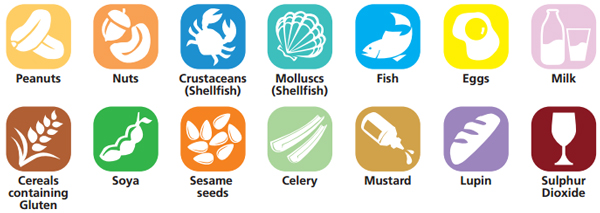 Food Allergens
Food Allergens
Food labelling laws changing to require clearer provision of Food allergens information.
As a result of both European and UK regulations, the law regarding food allergens labelling is changing from 13 December 2014.
The aim is to provide allergen information in a clearer and more consistent way.
The Food Information to Consumers Regulations 2011 and Food Information Regulations 2014 change the way allergen information appears on labels and on foods that are pre-packed, sold loose or served for consumption outside of the home. As such, this affects all ‘Food Business Operators’, including restaurants, pubs, cafés, fast food/takeaway establishments, butchers, bakers, delicatessens, works canteens, food manufacturers or packers, etc.
The changes are:
-
Any of the 14 allergens that are on the regulatory list must be emphasised on the label, if they are used as ingredients, or have been used in in the preparation or manufacture of a pre-packaged food. Businesses can choose what method they want to use to emphasise these allergens, for example, by listing them in bold, italics, highlighted or underlined, to help identify them.
-
Information about allergenic ingredients must be located in a single place, i.e., the ingredients list on pre-packed food. This means that the voluntary use of the current types of allergy boxes (such as: ‘contains nuts’) that provide a short cut to allergen information also given in the ingredients list will no longer be allowed.
-
These rules will also apply to loose foods (that can be bought without packaging) for example in supermarkets, delis, cafes and restaurants.
The 14 allergens on the regulatory list are:
-
Eggs.
-
Milk.
-
Fish.
-
Crustaceans (for example crab, lobster, crayfish, shrimp, prawn).
-
Molluscs (for example mussels, oysters, squid).
-
Peanuts.
-
Tree nuts (almonds, hazelnuts, walnuts, cashews, pecans, Brazils, pistachios, macadamia nuts or Queensland nuts).
-
Sesame seeds.
-
Cereals containing gluten (wheat (such as spelt, Khorasan wheat/Kamut), rye, barley, oats, or their hybridised strains).
-
Soya.
-
Celery and celeriac.
-
Mustard.
-
Lupin.
-
Sulphur dioxide and sulphites (at concentration of more than ten parts per million).
The regulations state the size of the labels and font that should display. Failure to comply with the regulations is a criminal offence and can result in a criminal prosecution and a fine.

